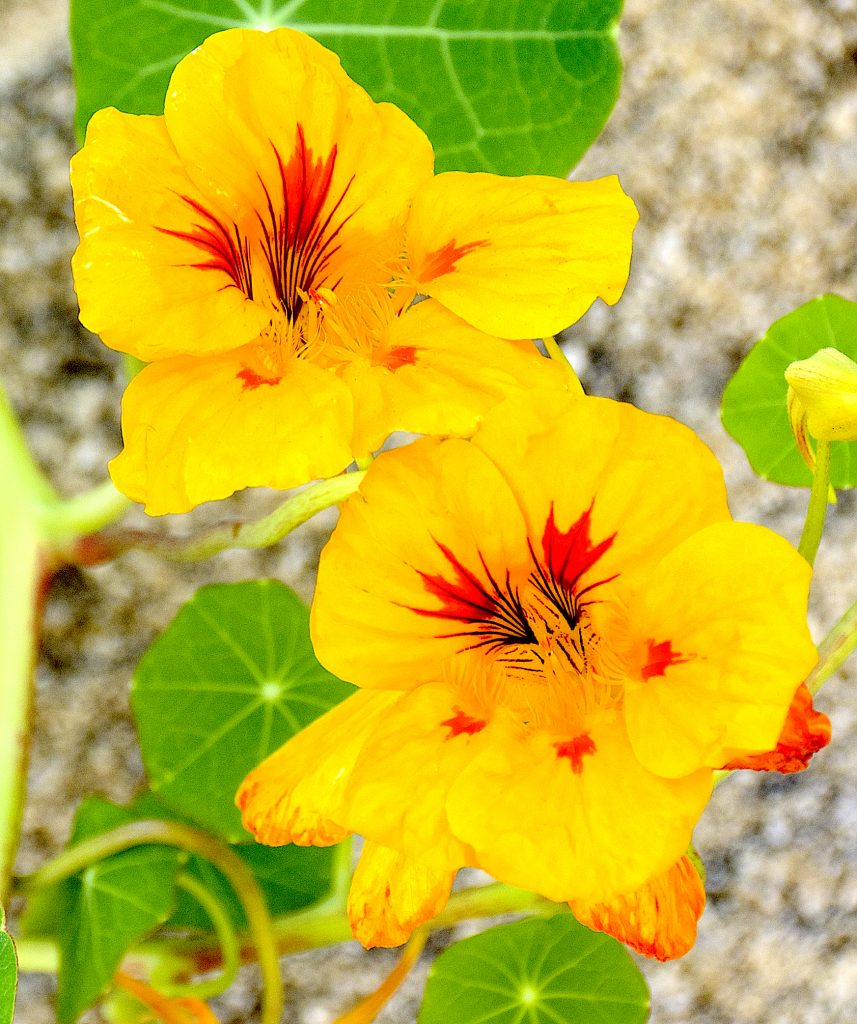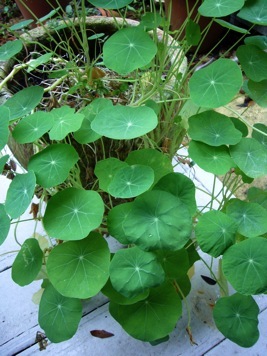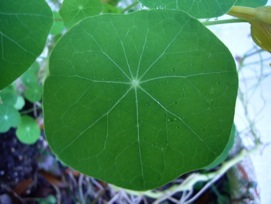
Nasturtiums are originally from Peru. Photo by Green Deane
Nasturtiums: Peppery Peruvian Natives
Do the peppery Nasturtiums make your nose twitch? Then you know how they got their common name. “Nasturtium” in Dead Latin means “twisting nose.”
Nasturtiums are among the most well-known edible flowers. Their leaves and stems are edible, too, but peppery. You can steal a snack or two out of a flower bed as long as you know the flower bed does not have any pesticides on it. Locally they like our mild-winters.
Nasturtium’s botanical name is Tropaeolum majus (trope-ee-OH-lum MAY-jus). It comes from the Dead Latin word tropaeum or trophy. That comes from the Greek word tropaio, meaning prize. Food used to be given to winners in athletic contests. The word for food in Greek is trofima. Anyway, a yellow-flowered Nasturtium twining up a post reminded Linnaeus —the fellow who started naming plants — of the practice used in ancient times of displaying shields and helmets of slain soldiers on the trunk of a tree at the scene of a battlefield. Majus means big, large or great. By the way, Latin was chosen to name plants because it is a dead language. No large group of people are speaking it as their native tongue so it is not evolving. Unlike the older, still living language of Greek, Latin is static.
Nasturtiums came to North America the long way. Discovered in Peru in the 1500’s, two species were taken back to Spain as a vegetables. It was a Dutch botanist who took the then short plants and developed the twisting vine Linnaeus named. Soon they were being grown for their flowers as well and spread across Europe. Then they came to North America with immigrants as early as 1759. Nasturtiums were also known as Indian Cress or Capucine Cress, in reference to the shape of the flower that was also similar to Capucine monks’ robe hoods.
Thomas Jefferson planted nasturtiums in his garden from at least 1774 on. He pickled the seeds and categorized the Nasturtium as a fruit along with the tomato (which is botanically a fruit but legally a vegetable. That came from a US supreme court ruling in the 1890s and involved different taxation rates for fruits, vegetables, and seeds. Since tomatoes — and beans — were used as vegetables rather than fruit and seeds, respectively, they were to be taxed like vegetables. ) While Nasturtiums are primarily cultivated they have escaped and naturalized in a few states and of course are wild in Peru.
Nasturtiums are easy to grow and aren’t picky about soil, light or water. Rich soil produces lots of leaves, poor soil lots of blossoms. Thus they are a natural indicator of the quality of your soil. The seeds, which germinate in a week to 10 days, are large so they make a good project for kid hands.
Dwarf Nasturtiums add a butterfly-like rainbows of color to annual beds and borders (and attract humming birds which pollinate them.) Trailing forms of Nasturtiums color fences, trellises, slopes and hanging containers. Aphids incidentally love Nasturtiums so organic gardeners like to plant them around the vegetable garden to “lure” aphids away from other plants. Nasturtium flowers, leaves and immature seed pods can be added to salads. They are rich in Vitamin C. The immature pods can be pickled and the mature seeds roasted for a peppery snack or ground and used like black pepper. My mother loved to eat their seeds. I lacto-ferment the seeds for three days, drain, then put in the frig with a little sugar and chardonnay to cover. Very tasty but they smell horrible while fermenting.
Like all wild plants with a good dose of oxalic acid they come with the warning not to eat them in large quantities. Odd that warning is never given for domesticated plants with higher levels of oxalic acid.
Bouquet Salad
Dressing: 1/4 c. white wine vinegar or champagne vinegar, 1 T. Dijon mustard, 1C. vegetable oil, salt and pepper to taste, 1/4 C. light olive oil, 1 T. freshly squeezed lime juice, finely grated zest of lime.
Salad: 3 heads radicchio, washed and dried, 1 small bunch of chives, 1 lb. tender spinach, trimmed, washed and dried, nasturtium blossoms.
In a bowl, whisk together the dressing ingredients. Just before serving, toss, toss greens, chives and flowers with enough dressing to coat. Yield 8 servings.
Nasturtium Bundles
Gather medium size nasturtium leaves. Rinse with cool water and dry. Set aside. In a small bowl: mix 1 – 8 oz. package cream cheese, softened, 1 small can crushed pineapple, drained and 3 T. of any of the herb choices ( washed, dried and chopped): thyme, lemon verbena, lemon scented geranium leaves or flowers, basil, chives or rose petals – pith removed (white part at base of petal). After blending: With a knife, generously spread the cream cheese mixture on each nasturtium leaf, roll up and pile on a serving platter. Add nasturtium flowers as an accent. Recipe created by Kelly Wisner.
Steamed Beets with Nasturtium
4 whole beets steamed
6 nasturtium leaves, shredded
4 nasturtium flowers
Dressing:
1/3 C olive oil
2 T balsamic vinegar
1/2 tsp salt of choice, plain or flavored
Steam peeled beets, covered, until just able to pierce them with a fork (about 30 minutes.) Cool. Cut into bite sized wedges. Whisk the dressing. Shred nasturtium leaves and sprinkle on top of beets, drizzle dressing over all. Decorate with flowers. Serves 3-4.
Green Deane’s “Itemized” Plant Profile
IDENTIFICATIOIN: Flower: Nasturtiums grow showy with spots of bright blossoms in masses of foliage. Leaves are round and scalloped, flowers funnel shape with a spur on the underside. They come in rich shades of yellow, orange, , pink, red and brown, dwarfed to climbing, a favorite of leaf miners.
TIME OF YEAR: Plant in spring and summer in northern climes, spring, fall and winter in Florida in southern states with successive plantings. Like rich soil but can grow in sandy areas with irrigation. Tolerate neglect
ENVIRONMENT: Usually found in gardens, flower beds and flower pots. Make sure no pesticides have been used. They are naturalized in some urban areas.
METHOD OF PREPARATION: Peppery leaves in salads or out of hand hot snack. Flowers can adorn salads, seeds can be pickled and used like capers.





